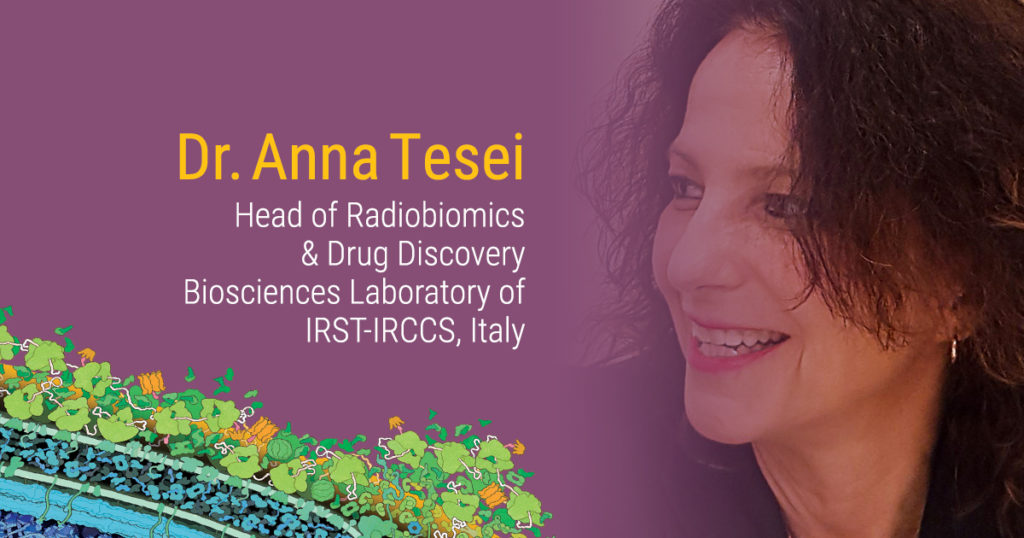Glioblastoma (GBM) is an aggressive type of brain tumor, and one of the deadliest cancers. GBM is often treated with surgery, radiation and chemotherapy, but even if the initial treatment is successful, a majority of patients relapse within months. One reason why GBM is so difficult to treat is the hypoxic (low-oxygen) tumor environment. It is known that hypoxic cells are resistant to radiotherapy; the greater the number of tumor stem cells in a hypoxic environment, the less efficient radiotherapy is at controlling tumor growth.
A new therapeutic approach aims to remove the hypoxic environment in GBM by administering pure oxygen to patients at high pressure, known as “hyperbaric oxygen (HBO) therapy”. Previous studies have shown that HBO improves the efficacy of radiotherapy in GBM patients. However, the therapeutic mechanism of HBO was largely unknown. That is, until now.
Dr. Anna Tesei, the Head of Radiobiomics and Drug Discovery at the Biosciences Laboratory of IRST-IRCCS in Italy, recently published a study on the mechanism in which HBOT affects GBM tumor cells and the tumor environment. “The main purpose of our study was to provide a preclinical rationale for the use of hyperbaric oxygen in association with radiotherapy for the treatment of GBM,” she says.

The first challenge for Dr. Tesei’s team was to generate an in vitro model of the tumor microenvironment using co-culture systems and 3D cultures. They were able to obtain tumor samples from patients to create GBM patient-derived primary cells. To mimic HBO in these cells, they grew the cells in a hypoxic (4% oxygen) environment, then placed the cells in a hyperbaric chamber where air was replaced with 100% oxygen at high pressure.
In response to low levels of oxygen, GBM cells activate the transcription factor HIF1, which reprograms glucose metabolism towards increased anaerobic glycolysis in an attempt to rebalance the reduced oxygen supply. More specifically, HIF1 activates genes involved in transporting glucose inside the cell (e.g., GLUT1, GLUT3) and transporting lactate (the ultimate product of anaerobic glycolysis) outside the cell. Dr. Tesei’s team wanted to know whether HBO could reverse glucose metabolism in GBM cells. To achieve this, they used a collection of bioluminescent metabolite assays from Promega.
“The glucose metabolism is a very complex process affected by several factors whose activity is not always easy to read. Promega is well known for the development of a series of extremely reproducible and easy-to-use assays aimed at characterizing the cellular metabolic state. These assays offer the possibility to study this complex metabolic pathway in a simple, accurate and precise matter,” says Dr. Tesei. “We tried to use the most appropriate detection techniques, using data in the literature as a reference, to provide the best possible analysis of what happens to the glucose metabolism of glioma cells after exposure to HBO.”
Using assays that measure specific metabolites, such as lactate, glucose uptake, NAD/NADH and NADP/NADPH, Dr. Tesei’s team found that HBO indeed induces glucose metabolism reprogramming in GBM cells. They observed reduced glucose uptake, lactic acid production, and GLUT1 expression. An increase in NADP suggested a shift in glucose metabolism towards mitochondrial respiration, the metabolic pathway normally used by differentiated cells. Reduction in NADPH indicated a decrease in the synthesis of nucleic acids, proteins and fatty acids generated from the pentose phosphate pathway, which is necessary for tumor growth. Overall, the metabolic changes after HBO treatment are characteristic of lower tumor cell proliferation and invasion.
Besides changes in glucose metabolism, HBO also appears to trigger inflammasome activation, followed by pyroptosis, a form of programmed cell death induced by caspase-1. The increase in cell death was further confirmed using a cytotoxicity assay based on LDH release. (Both caspase-1 and LDH were also measured using Promega assays.) The study also showed that after HBO treatment, GBM cells communicated with immune cells within the tumor environment by sending messages using exosomes, further activating the innate immune system.
In summary, this study was the first to demonstrate the effect of HBO on GBM cells in vitro, including glucose metabolism reprogramming, inflammasome activation and cross-talk with immune cells. “GBM is a very complex disease characterized by a high ability to adapt to the adverse conditions induced by chemo- and radiotherapy treatments. Up until now, these treatments have not produced satisfactory results in the clinic yet,” says Dr. Tesei. “Our study focuses on understanding how it would be possible to counteract this super aggressive form of tumor using alternative therapeutic approaches such as targeting cell metabolism and the reactivation of the immune system.”
Learn more about our easy-to-use bioluminescent assays to measure metabolic activity, including glucose uptake, lactate, glutamine, oxidative stress, and dinucleotide detection assays.
Reference:
Arienti C. et al. (2021) High-pressure oxygen rewires glucose metabolism of patient-derived glioblastoma cells and fuels inflammasome response. Cancer Lett. 152–166.
Latest posts by Johanna Lee (see all)
- Microfluidic Organoids Could Revolutionize Breast Cancer Treatment - March 25, 2025
- Bacteria From Insect Guts Could Help Degrade Plastic - January 28, 2025
- A Diabetes Drug, Metformin, Slows Aging in Male Monkeys - December 19, 2024
